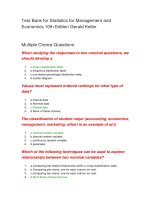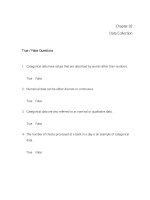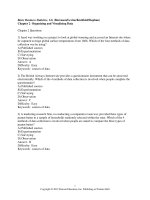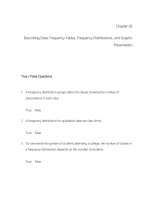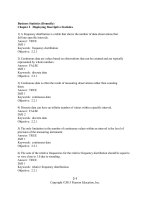Statistics salkind 4e test bank ch03
Bạn đang xem bản rút gọn của tài liệu. Xem và tải ngay bản đầy đủ của tài liệu tại đây (334.61 KB, 14 trang )
Chapter 3: Vive la Différence: Understanding Variability
Test Bank
MULTIPLE CHOICE
1. Which of the following measures how scores differ from each other?
a. Skewness
b. Kurtosis
c. Average
d. Variability
ANS: D
PTS: 1
DIF: Easy
REF: Why Understanding Variability Is Important
OBJ: Why variability is valuable as a descriptive tool
COG: Knowledge
2. Which of the following is NOT a measure of variability?
a. Mean
b. Standard deviation
c. Variance
d. Range
ANS: A
PTS: 1
DIF: Easy
REF: Why Understanding Variability Is Important
OBJ: Why variability is valuable as a descriptive tool
COG: Knowledge
3. In order to calculate the variance, which of the following must you know?
a. Range
b. Median
c. Mean
d. Mode
ANS: C
PTS: 1
DIF: Easy
OBJ: Computing the range, standard deviation, and variance
REF: Computing the Variance
COG: Knowledge
4. What is another term for variability?
a. Flux or variation
b. Scattergram
c. Skewness
d. Spread or dispersion
ANS: D
PTS: 1
DIF: Easy
REF: Why Understanding Variability Is Important
OBJ: Why variability is valuable as a descriptive tool
5. What are the three tools used to assess variability?
a. Range, standard deviation, and variance
b. Mean, median, and mode
c. Variance, range, and mean
d. Mean, standard deviation, and skewness
ANS: A
PTS: 1
DIF: Easy
REF: Why Understanding Variability Is Important
COG: Knowledge
OBJ: Why variability is valuable as a descriptive tool
COG: Knowledge
6. Which measure of variability is easiest to calculate?
a. Standard deviation
b. Mode
c. Range
d. Variance
ANS: C
PTS: 1
DIF: Easy
OBJ: Computing the range, standard deviation, and variance
REF: Computing the Range
COG: Comprehension
7. Which measure of variability is most general and, hence, least useful?
a. Median
b. Range
c. Standard deviation
d. Mean deviation
ANS: B
PTS: 1
DIF: Easy
OBJ: Computing the range, standard deviation, and variance
REF: Computing the Range
COG: Knowledge
8. Which measure of variability should never be used alone to reach conclusions regarding the
variance of a distribution?
a. Standard deviation
b. Mode
c. Variance
d. Range
ANS: D
PTS: 1
DIF: Easy
OBJ: Computing the range, standard deviation, and variance
REF: Computing the Range
COG: Knowledge
9. Which measure of variability is a measure of the average distance from the mean?
a. Standard deviation
b. Range
c. Median
d. Mode
ANS: A
PTS: 1
DIF: Easy
REF: Computing the Standard Deviation
OBJ: Computing the range, standard deviation, and variance
COG: Knowledge
10. What is the range for the following set of scores: 29, 48, 22, 37, 55?
a. 26
b. 33
c. 37
d. 55
ANS: B
PTS: 1
DIF: Easy
OBJ: Computing the range, standard deviation, and variance
REF: Computing the Range
COG: Application
11. What is the range for the following set of scores: 34, 14, 17, 57, 22?
a. 14
b. 17
c. 57
d. 43
ANS: D
PTS: 1
DIF: Easy
OBJ: Computing the range, standard deviation, and variance
REF: Computing the Range
COG: Application
12. What is the range for the following set of scores: 117, 249, 326, 47, 442?
a. 117
b. 395
c. 326
d. 442
ANS: B
PTS: 1
DIF: Easy
OBJ: Computing the range, standard deviation, and variance
REF: Computing the Range
COG: Application
13. If you have a lowest score of 21 and a range of 47, your highest score will be _______.
a. 26
b. 21
c. 47
d. 68
ANS: D
PTS: 1
DIF: Medium
OBJ: Computing the range, standard deviation, and variance
REF: Computing the Range
COG: Application
14. Which of the following measures how different scores are from one particular score?
a. Average
b. Correlation
c. Variability
d. Standard Deviation
ANS: C
PTS: 1
DIF: Easy
REF: Why Understanding Variability Is Important
OBJ: Why variability is valuable as a descriptive tool
COG: Knowledge
15. What is the most common measure of variability?
a. Range
b. Standard deviation
c. Variance
d. Mean deviation
ANS: B
PTS: 1
DIF: Easy
REF: Computing the Standard Deviation OBJ: Why variability is valuable as a descriptive tool
COG: Knowledge
16. When reporting descriptive data such as the mean, what additional information should also be
reported that expresses how different the scores are in the distribution?
a. Variability
b. Outlier
c. Skew
d. Percentile
ANS: A
PTS: 1
DIF: Easy
REF: Why Understanding Variability Is Important
OBJ: Why variability is valuable as a descriptive tool
COG: Comprehension
17. If you subtract the smallest number in the distribution from the largest, what type of
variability is being calculated?
a. Variance
b. Range
c. Outliers
d. Standard Deviation
ANS: B
PTS: 1
DIF: Easy
OBJ: Computing the range, standard deviation, and variance
REF: Computing the Range
COG: Comprehension
18. In the formula for computing the range, what does the letter h represent?
a. Summation
b. Sample size
c. Highest score
d. Lowest score
ANS: C
PTS: 1
DIF: Medium
OBJ: Computing the range, standard deviation, and variance
REF: Computing the Range
COG: Knowledge
19. In the formula for computing the range, what does the letter l represent?
a. Range
b. Variability
c. Highest score
d. Lowest score
ANS: D
PTS: 1
DIF: Medium
OBJ: Computing the range, standard deviation, and variance
REF: Computing the Range
COG: Knowledge
20. In the formula for computing the range, this is used to represent the range:
a. rho
b. Ran.
c. r
d. rhi
ANS: C
PTS: 1
DIF: Medium
OBJ: Computing the range, standard deviation, and variance
REF: Computing the Range
COG: Knowledge
21. The highest score minus the lowest score is equal to the _______.
a. Standard deviation
b. Inclusive range
c. Exclusive range
d. Variance
ANS: C
PTS: 1
DIF: Medium
OBJ: Computing the range, standard deviation, and variance
REF: Computing the Range
COG: Knowledge
22. The highest score minus the lowest score plus one is equal to the _______.
a. Exclusive range
b. Variance
c. Inclusive range
d. Standard deviation
ANS: C
PTS: 1
DIF: Medium
OBJ: Computing the range, standard deviation, and variance
REF: Computing the Range
COG: Knowledge
23. In the formula for calculating the standard deviation, what does the Greek letter represent?
a. Summation
b. Sample size
c. Mean score for group
d. Individual scores
ANS: A
PTS: 1
DIF: Medium
REF: Computing the Standard Deviation
OBJ: Computing the range, standard deviation, and variance
COG: Knowledge
24. In the formula for calculating the variance, what does the letter n represent?
a. Summation
b. Sample size
c. Mean score for group
d. Individual score
ANS: B
PTS: 1
DIF: Medium
OBJ: Computing the range, standard deviation, and variance
REF: Computing the Variance
COG: Knowledge
25. When calculating the standard deviation, what must be done in order to obtain an unbiased
estimate?
a. Subtract 1 from X
b. Add 1 to X
c. Subtract 1 from n
d. Add 1 to n
ANS: C
PTS: 1
DIF: Medium
REF: Why n – 1? What’s Wrong With Just n?
OBJ: Computing the range, standard deviation, and variance
COG: Knowledge
26. Which of the following sets of scores has the greatest variability?
a. 7, 10, 11, 15, 19
b. 7, 7, 8, 8, 10, 11
c. 7, 7, 7, 7, 7, 7
d. 6, 6, 7, 7, 7, 7
ANS: A
PTS: 1
DIF: Hard
REF: Why Understanding Variability Is Important
OBJ: Computing the range, standard deviation, and variance
COG: Application
27. Which of the following sets of scores has the least variability?
a. 5, 4, 5, 6, 5
b. 7, 2, 8, 9, 4
c. 12, 14, 17, 19, 21
d. 1, 2, 1, 7, 9
ANS: A
PTS: 1
DIF: Hard
REF: Why Understanding Variability Is Important
OBJ: Computing the range, standard deviation, and variance
COG: Application
28. Variability is a measure of how much individual scores differ from the _______.
a. Mean
b. Range
c. Standard deviation
d. Variance
ANS: A
PTS: 1
DIF: Easy
REF: Why Understanding Variability Is Important
OBJ: Computing the range, standard deviation, and variance
COG: Knowledge
29. What is the formula for calculating the exclusive range?
a. r - n + 1
b. h - l + 1
c. (h - 1) r
d. h - l
ANS: D
PTS: 1
DIF: Medium
OBJ: Computing the range, standard deviation, and variance
REF: Computing the Range
COG: Knowledge
30. What is the formula for calculating the inclusive range?
a. r - n + 1
b. h - l + 1
c. (h - l) r
d. h - l
ANS: B
PTS: 1
DIF: Medium
OBJ: Computing the range, standard deviation, and variance
REF: Computing the Range
COG: Knowledge
31. The sum of the absolute value of the deviations from the mean divided by the number of
scores is equal to the _______.
a. Mean
b. Standard deviation
c. Mean deviation
d. Variance
ANS: C
PTS: 1
DIF: Medium
REF: And Now . . . Using Excel’s STDEV.S Function
OBJ: Computing the range, standard deviation, and variance
COG: Knowledge
32. The sum of the deviations from the mean will always be equal to _______.
a. 0
b. 1
c. n - 1
d. n + 1
ANS: A
PTS: 1
DIF: Hard
REF: And Now . . . Using Excel’s STDEV.S Function
OBJ: Computing the range, standard deviation, and variance
33. What is obtained by squaring the standard deviation?
a. Mean deviation
b. Range
c. Variance
COG: Knowledge
d. Squared deviation
ANS: C
PTS: 1
DIF: Medium
OBJ: Computing the range, standard deviation, and variance
REF: Computing the Variance
COG: Knowledge
34. What is obtained by taking the square ROOT of the variance?
a. Standard deviation
b. Mean
c. Mode
d. Mean deviation
ANS: A
PTS: 1
DIF: Hard
OBJ: Computing the range, standard deviation, and variance
REF: Computing the Variance
COG: Comprehension
35. Which of the following is one way to represent the standard deviation?
a. s
b. s2
c. s(2)
d. s / n
ANS: A
PTS: 1
DIF: Medium
REF: Computing the Standard Deviation
OBJ: Computing the range, standard deviation, and variance
COG: Knowledge
36. Which of the following is one way to represent the variance?
a. s
b. s2
c. s(2)
d. s / n
ANS: B
PTS: 1
DIF: Medium
OBJ: Computing the range, standard deviation, and variance
REF: Computing the Variance
COG: Knowledge
37. Unbiased estimates
a. Subtract 1 from the sample size
b. Add 1 to the sample size
c. Do not change the sample size
d. Multiply the sample size by 1
ANS: A
PTS: 1
DIF: Medium
REF: Why n – 1? What’s Wrong With Just n?
OBJ: Computing the range, standard deviation, and variance
COG: Knowledge
38. Unbiased estimates
a. Are less conservative estimates of sample statistics
b. Are more conservative estimates of sample statistics
c. Are less conservative estimates of population parameters
d. Are more conservative estimates of population parameters
ANS: D
PTS: 1
DIF: Medium
REF: Why n – 1? What’s Wrong With Just n?
OBJ: Computing the range, standard deviation, and variance
COG: Knowledge
39. What is the range for the following set of scores: 10, 15, 12, 18, 19, 16, 12?
a. 7
b. 8
c. 9
d. 10
ANS: C
PTS: 1
DIF: Easy
OBJ: Computing the range, standard deviation, and variance
REF: Computing the Range
COG: Application
40. What is the standard deviation for the following set of scores: 10, 15, 12, 18, 19, 16, 12?
a. 3.36
b. 11.29
c. 6.47
d. 17.78
ANS: A
PTS: 1
DIF: Medium
REF: Computing the Standard Deviation
OBJ: Computing the range, standard deviation, and variance
COG: Application
41. What is the variance for the following set of scores: 10, 15, 12, 18, 19, 16, 12?
a. 3.36
b. 11.29
c. 6.47
d. 17.18
ANS: B
PTS: 1
DIF: Medium
OBJ: Computing the range, standard deviation, and variance
REF: Computing the Variance
COG: Application
42. What is the range for the following set of scores: 20, 24, 26, 22, 18, 16, 18?
a. 10
b. 11
c. 12
d. 13
ANS: A
PTS: 1
DIF: Easy
OBJ: Computing the range, standard deviation, and variance
REF: Computing the Range
COG: Application
43. What is the standard deviation for the following set of scores: 20, 24, 26, 22, 18, 16, 18?
a. 12.95
b. 3.60
c. 6.55
d. 24
ANS: B
PTS: 1
DIF: Medium
REF: Computing the Standard Deviation
OBJ: Computing the range, standard deviation, and variance
COG: Application
44. What is the variance for the following set of scores: 20, 24, 26, 22, 18, 16, 18?
a. 12.95
b. 3.60
c. 6.55
d. 24
ANS: A
PTS: 1
DIF: Medium
OBJ: Computing the range, standard deviation, and variance
REF: Computing the Variance
COG: Application
45. Which of the following sets of data has no variability?
a. 1, 2, 5, 4, 7
b. 7, 7, 7, 2, 9
c. 5, 5, 5, 5, 5
d. 0, 0, 0, 0, 10
ANS: C
PTS: 1
DIF: Easy
REF: Why Understanding Variability Is Important
OBJ: Why variability is valuable as a descriptive tool
COG: Application
46. What is the standard deviation squared?
a. Range
b. Mean deviation
c. Variance
d. This cannot be computed
ANS: C
PTS: 1
DIF: Medium
OBJ: Computing the range, standard deviation, and variance
REF: Computing the Variance
COG: Knowledge
47. The variance of a group of scores is 4. What is the standard deviation?
a. 3.5
b. 18
c. 2
d. 16
ANS: C
PTS: 1
DIF: Hard
OBJ: Computing the range, standard deviation, and variance
REF: Computing the Variance
COG: Application
48. If (X – M)2 = 235, and n = 29, what is s?
a. 8.10
b. 8.39
c. 2.90
d. 43.64
ANS: C
PTS: 1
DIF: Hard
REF: Computing the Standard Deviation
OBJ: Computing the range, standard deviation, and variance
COG: Application
49. Which of the following must also be known in order to compute the standard deviation?
a. Mode
b. Mean
c. Range
d. Median
ANS: B
PTS: 1
DIF: Easy
REF: Computing the Standard Deviation
OBJ: Computing the range, standard deviation, and variance
50. Biased estimates can be used
a. To describe a sample
COG: Knowledge
b. To describe a population
c. To describe a sample or a population
d. None of the above
ANS: A
PTS: 1
DIF: Medium
REF: Why n – 1? What’s Wrong With Just n?
OBJ: Computing the range, standard deviation, and variance
COG: Comprehension
51. Unbiased estimates can be used
a. To make sample estimates
b. To make population estimates
c. To make sample or population estimates
d. None of the above
ANS: B
PTS: 1
DIF: Medium
REF: Why n – 1? What’s Wrong With Just n?
OBJ: Computing the range, standard deviation, and variance
COG: Comprehension
52. When using sample estimates to estimate population parameters, you should use
a. Biased statistics
b. Unbiased statistics
c. Either biased or unbiased statistics
d. None of the above
ANS: B
PTS: 1
DIF: Medium
REF: Why n – 1? What’s Wrong With Just n?
OBJ: Computing the range, standard deviation, and variance
COG: Comprehension
53. As your sample size grows larger, the n - 1 adjustment for the standard deviation has a
a. Greater impact on your calculation
b. Smaller impact on your calculation
c. The impact does not vary
d. This cannot be determined
ANS: B
PTS: 1
DIF: Medium
REF: Why n – 1? What’s Wrong With Just n?
OBJ: Computing the range, standard deviation, and variance
COG: Knowledge
54. As your sample size grows larger, your standard deviation will be
a. A more accurate estimate of the population
b. A less accurate estimate of the population
c. The accuracy will not change
d. This cannot be determined
ANS: A
PTS: 1
DIF: Medium
REF: Why n – 1? What’s Wrong With Just n?
OBJ: Computing the range, standard deviation, and variance
55. If n = 24 and s = 1.56, what is the variance?
a. 2.43
b. 1.25
c. 0.06
d. 0.0065
COG: Knowledge
ANS: A
PTS: 1
DIF: Medium
OBJ: Computing the range, standard deviation, and variance
REF: Computing the Variance
COG: Application
56. If you have a standard deviation of 5, your variance will be _______.
a. 4
b. 25
c. 5
d. 625
ANS: B
PTS: 1
DIF: Medium
OBJ: Computing the range, standard deviation, and variance
REF: Computing the Variance
COG: Application
57. If you have a variance of 9, your standard deviation will be _______.
a. 9
b. 81
c. 3
d. 0
ANS: C
PTS: 1
DIF: Medium
REF: Computing the Standard Deviation
OBJ: Computing the range, standard deviation, and variance
COG: Application
58. If (X – M)2 = 235, and n = 29, what is s2?
a. 8.10
b. 8.39
c. 2.90
d. 43.64
ANS: B
PTS: 1
DIF: Medium
OBJ: Computing the range, standard deviation, and variance
REF: Computing the Variance
COG: Application
59. (X – M)2 = 235, and n = 29, what is s?
a. 11.3
b. 23.5
c. 8.39
d. 2.90
ANS: D
PTS: 1
DIF: Medium
REF: Computing the Standard Deviation
OBJ: Computing the range, standard deviation, and variance
COG: Application
60. What is the mean for the following set of scores: 20, 24, 26, 22, 18, 16, 18?
a. 18
b. 24
c. 20.57
d. 14.57
ANS: C
PTS: 1
DIF: Easy
REF: Computing the Standard Deviation
OBJ: Computing the range, standard deviation, and variance
TRUE/FALSE
COG: Application
1. The variance is more difficult to interpret than the standard deviation.
ANS: T
PTS: 1
DIF: Medium
REF: The Standard Deviation Versus the Variance
OBJ: Computing the range, standard deviation, and variance
COG: Comprehension
2. Unbiased estimates are considered to be less conservative estimates.
ANS: F
PTS: 1
DIF: Medium
REF: Why n – 1? What’s Wrong With Just n?
OBJ: Computing the range, standard deviation, and variance
COG: Knowledge
3. The standard deviation is sensitive to extreme scores.
ANS: T
PTS: 1
DIF: Medium
OBJ: Computing the range, standard deviation, and variance
REF: What’s the Big Deal?
COG: Knowledge
4. The exclusive range is more commonly used in research articles as compared with the
inclusive range.
ANS: T
PTS: 1
DIF: Easy
OBJ: Computing the range, standard deviation, and variance
REF: Computing the Range
COG: Knowledge
5. A greater standard deviation indicates less variance.
ANS: F
PTS: 1
DIF: Medium
REF: Computing the Standard Deviation
OBJ: Computing the range, standard deviation, and variance
COG: Comprehension
6. A standard deviation equal to 0 indicates no variance in your data.
ANS: T
PTS: 1
DIF: Easy
OBJ: Computing the range, standard deviation, and variance
REF: What’s the Big Deal?
COG: Knowledge
7. It is possible for a set of data to have no variability.
ANS: T
PTS: 1
DIF: Easy
REF: Why Understanding Variability Is Important
OBJ: Why variability is valuable as a descriptive tool
COG: Comprehension
SHORT ANSWER
1. Define variability.
ANS:
Variability reflects how scores differ from one another. It is also a measure of how different
scores are from the mean.
PTS: 1
DIF: Medium
REF: Why Understanding Variability Is Important
OBJ: Why variability is valuable as a descriptive tool
COG: Comprehension
2. What are the strengths and limitations of the range?
ANS:
The range is the most general estimate of how far apart data points are from one another. Its
strength is that it is easy to compute while its limitation is that it does not provide insight into
how each score deviates from each other or the mean.
PTS: 1
DIF: Medium
REF: Computing the Range
OBJ: Computing the range, standard deviation, and variance
COG: Comprehension
3. What is the difference between the inclusive and exclusive range?
ANS:
The inclusive range is the highest score minus the lowest score plus one. The exclusive range,
which is more often used in journal articles, is the highest score minus the lowest score.
PTS: 1
DIF: Medium
REF: Computing the Range
OBJ: Computing the range, standard deviation, and variance
COG: Comprehension
4. When computing the standard deviation, why are the deviations from the mean squared?
ANS:
In order to compute the standard deviation (the average distance a score is from the mean),
you need an average of the deviations. If you summed up the deviations from the mean, the
sum would always be zero (arithmetic mean). By squaring the deviations, the negative signs
disappear so that in the next step they can be summed without having the sum equal to zero,
thus allowing the computations of the standard deviation to be completed.
PTS: 1
DIF: Medium
REF: Computing the Range
OBJ: Computing the range, standard deviation, and variance
COG: Comprehension
5. Why is the square root taken when computing s?
ANS:
In order to compute the standard deviation, the deviations are squared. The square root of the
standard deviation is taken in order to return to the same units in which the values were
originally measured.
PTS: 1
DIF: Medium
REF: Computing the Standard Deviation
OBJ: Computing the range, standard deviation, and variance
COG: Comprehension
6. How does a biased standard deviation differ from an unbiased standard deviation?
ANS:
The biased standard deviation uses n in the denominator of its formula while the unbiased
standard deviation uses n - 1 in the denominator of its formula. The unbiased standard
deviation is used so as to not underestimate the population standard deviation.
PTS: 1
DIF: Hard
REF: Why n – 1? What’s Wrong With Just n?
OBJ: Computing the range, standard deviation, and variance
COG: Comprehension
7. How are the standard deviation and the variance similar? How are they different?
ANS:
The standard deviation and variance are similar in that both are measures of variability and
both are computed using similar formulas. They are different because the standard deviation is
stated in the original units from which it is derived while the variance is stated in squared
units.
PTS: 1
DIF: Medium
REF: The Standard Deviation Versus the Variance
OBJ: Computing the range, standard deviation, and variance
COG: Comprehension
8. Can the measures of central tendency and the measures of variability be used together to
describe a set of scores? If so, how?
ANS:
Yes, the measures of central tendency and measures of variability can and should be used
together to describe a distribution of scores. The measures of central tendency describe the
central points of a distribution while the measures of variability describe how spread out the
scores are from one another and the mean.
PTS: 1
DIF: Medium
REF: Why Understanding Variability Is Important
OBJ: Why variability is valuable as a descriptive tool
COG: Comprehension
9. What are the three measures of variability? Which is the most commonly reported?
ANS:
The three measures of variability are the range, the standard deviation, and the variance.
Although each is important, the standard deviation is the most useful and most commonly
used index.
PTS: 1
DIF: Easy
REF: Why Understanding Variability Is Important
OBJ: Computing the range, standard deviation, and variance
COG: Knowledge
